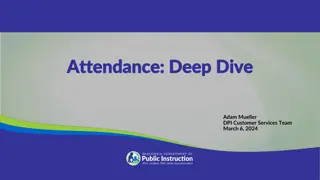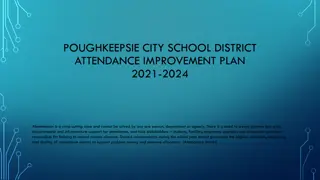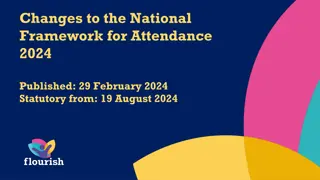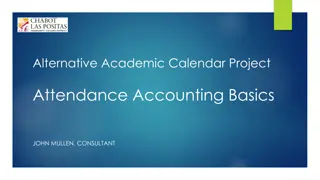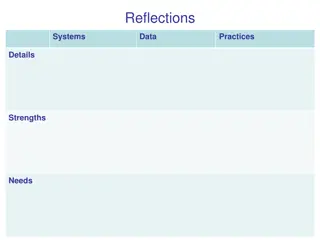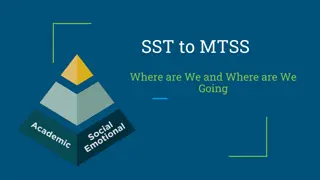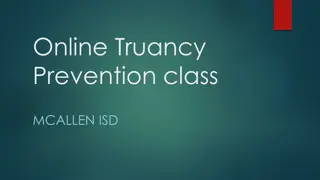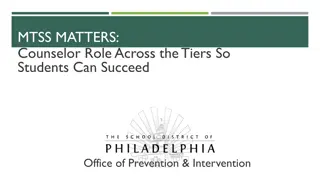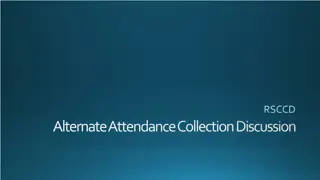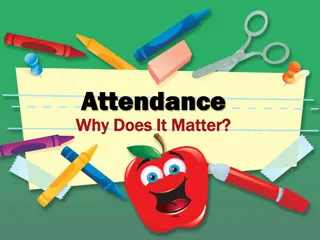Implementing a Multi-Tiered System of Support (MTSS) for School Attendance
A Multi-Tiered System of Support (MTSS) for school attendance consists of three tiers of intervention involving teachers, schools, children, parents, and external agencies. Data-driven decision-making and training are essential components aligned with the Department for Education's guidelines. Roles and responsibilities of each stakeholder are clearly defined at different intervention tiers for successful implementation.
Download Presentation

Please find below an Image/Link to download the presentation.
The content on the website is provided AS IS for your information and personal use only. It may not be sold, licensed, or shared on other websites without obtaining consent from the author.If you encounter any issues during the download, it is possible that the publisher has removed the file from their server.
You are allowed to download the files provided on this website for personal or commercial use, subject to the condition that they are used lawfully. All files are the property of their respective owners.
The content on the website is provided AS IS for your information and personal use only. It may not be sold, licensed, or shared on other websites without obtaining consent from the author.
E N D
Presentation Transcript
A Multi-Tiered System of Support (MTSS) for school attendance involves three tiers of intervention, with roles for teachers, the school, children, parents and external agencies including the Local Authority. Data-driven decision-making and training requirements are pivotal to the implementation of the system. The system aligns with the Department for Education's (DFE) "Working Together to Improve School Attendance" guidelines. - Data Decision-Making: Regularly collect, analyse, and use attendance data at each tier to inform decisions and interventions. - Training Requirements: School staff should receive appropriate training at each tier to effectively implement attendance strategies. - External agencies: External agencies play a crucial role in data analysis, resource allocation, and training provision to support schools in improving attendance. - Children and Parents: Effective communication and co-creation of any intervention support is pivotal to the success of the MTSS approach.
Role of Teachers and School Role of Children Meet and Greet children. Create positive classroom environments. Build positive relationships with all children and adults. Recognise individual and collective achievements. Implement evidence-based teaching strategies. Monitor daily attendance and punctuality additional support. Attend school regularly and be punctual. Engage actively in classroom activities. Support other children. Recognise the achievements of other children. Share when you have a concern. Tier 1 Universal Strategies Role of External Agencies Role of Parents Ensure children attend school regularly and on time. Understand and support any concerns your child may have. Communicate with the school regarding absence. Recognise personal achievements. Communicate with teachers about any concerns. Provide resources and training to teachers on effective classroom strategies. Collaborate with schools on attendance initiatives. Support a comprehensive and inclusive school-wide approach that encompasses both attendance and mental health.
Role of Teachers and School Role of Children Proactively use data information to identify children who are PA and at risk of PA. Work with each identified child and families to understand and address the reasons for absence, including any in-school or out of school barriers to attendance. Implement agreed strategies in daily practice. Monitor progress. Recognise achievements. Co-create and participate in any targeted interventions. Recognise personal achievements. Share concerns with staff. Continue to engage in school life. Tier 2 Individualised Strategies Role of Parents Role of External Agencies Work with the school to help understand their child s barriers to attendance. Proactively engage with the support offered to prevent the need for more formal support. Continue to communicate effectively with the school regarding absence. Signpost or provide access to services. Where there are out of school barriers, provide each identified child and their family with access to services they need. Provide professional development and early intervention support to the school.
Role of Teachers and School Role of Children Take an active part in the multi-agency effort with the local authority and other external partners. Use data driven information to identify children at risk of severe absence. Continuously assess and adapt strategies. Monitor progress. Recognise achievements. Actively engage in intensive interventions. Recognise personal achievements. Share concerns with staff. Continue to engage in school life. Tier 3 Higher Needs Strategies Role of External Agencies Role of Parents Offer specialised assessments and services for students with complex needs. Collaborate closely with the school on creating and implementing highly specialised interventions Continue to communicate with the school. Take an active role in the multi-agency effort. Provide intensive training and consultation. Take an active part in the multi-agency effort with the school and other external partners.




